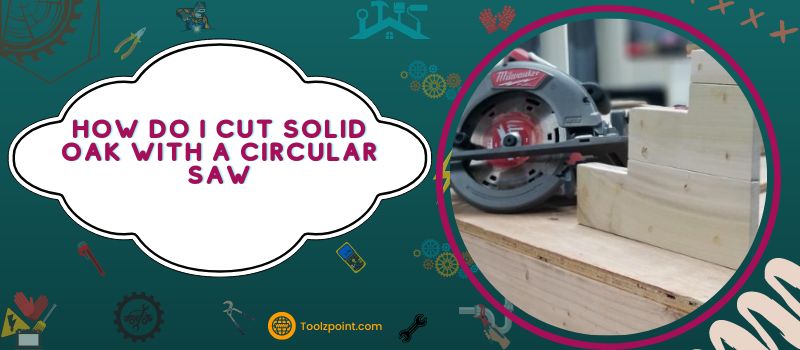A panel of solid oak can put your sawing game up for a challenge. This dense hardwood is very mischievous and hard to tame with the circular saw.
To cut solid oat you have to choose the blade with high tooth count and carbide-tipped combination blades. Then, you can cut the board by setting the blade depth. Finish off with sanding the rough edges.
To avoid any mistakes and dilemmas, keep the tab on to read the whole article.

How Do I Cut Solid Oak With A Circular Saw?
Taming solid oak with a circular saw can even put sweat on the forehead of a professional. However, since when have humans turned away from a daring challenge? With proper guidance and perseverance, you can master this wood too. You take care of the perseverance while I guide you thoroughly to cut solid oak.
Blade’s Selection
A circular saw can accommodate numerous blades but for solid oak, the blade should be hard and tough. A blade with a high tooth count such as 40-60 teeth will ensure a smoother cut with less splintering.
Choose the carbide-tipped circular saw as they are durable and can withstand the heavy texture of solid oak. The teeth should be a combination of the flat and alternative top bevels (ATB). This type works fine to provide a more precise and smoother cut.
Also, take the thickness of the blade into consideration. The blade for cutting solid oak should be at least 0.1 inch thick. A thick blade will have more stability and won’t be susceptible to bending. Considering all attributes, Diablo by Freud “Freud D1050X Diablo 10” 50-tooth ATB Combo Saw Blade will be a safe option for you.
Mark The Cutline
An accurate cutline can lead your way when you are running the blade on the surface of the solid oak. To mark the cutline, you have to measure the dimensions of the solid oak. You can use a tape measure and a pencil to measure the panel.
After you have determined the cutline, you can mark the line with a grease pen or straight edge. As the texture of solid oak is dense and dark, the pencil print hardly stays on the surface. It is better to mark the cutline with something more permanent.
Setting The Depth Of The Blade
Did you know, you can adjust the blade’s depth in a circular saw? Although not all models have this feature, modern and newer models have the facility to adjust the blade’s depth to the maximum capacity.
To set the depth of the blade you have to take note of the thickness of the solid oak. If the panel is thinner, adjust the blade extending 1/4 inch below the bottom part of the board. However, if the panel is so thick that you need to run blades multiple times, set the depth to the fullest.
Clamping The Oak Board
Clamping means securely attaching the panel or board to the workstation so that it doesn’t move. It will deter the board from moving while cutting the boards. Make sure there is a gap between the workstation and the panel so that the blade doesn’t touch the table.
Safety Gears On
No matter what level you are on as a worker, you should never ignore safety, especially when the material is solid oak. An eye protection gig to guard your eyes against the sawdust and a noise-canceling tool to shield you from the screeching noise will suffice.
The Final Part
Now that you, the solid oak, and the circular saw are set, you can proceed with the cutting part. First, turn the circular saw on and make sure the circular saw is functioning. You can use the blade first on a scrap piece of oak to check whether it is cutting correctly or not.
Once you are satisfied with the performance of the blade, you can lower the blade and keep the blade on the edge of the cutline. Then, run the blade along the line slowly and steadily. If the cutline is longer, use a straight edge to keep you guided and focused.
Sand The Edges
Once you are done with cutting, you have to smoothen the cut edge. As the solid oak is very dense-textured wood, the cut will be a little rough and edgy. But you can easily use sandpaper to make the edge smoother and take out any splinters.
Factors To Consider For Cutting Solid Oak
For a smooth and plain cut on the oaks, some small changes can prove worthy. So, in addition to following the instructions on how to cut solid oak with a circular saw, you also should remember the factors that can be important for precise cuts.
Be Mindful About Cutting Motion
The cutting motion should be strong enough to push the dense barrier of oak and also soft enough to avoid putting extreme strain on the blade. Push the blade hard enough to penetrate inside the board and let the saw do the cutting.
Relief Cuts For Tight Curves
Excelling a tight curve on such a dense material is certainly not everyone’s cup of tea. But you can do it with a simple trick. That is to make relief cuts. This will guide the blade when you are curving the board. You can make multiple small cuts following the curve and remove the waste wood with a jigsaw.
Avoid Being Too Close To Knots
Oaks have several knots that are very hard and tough to cut through clearly. When you are drawing the cutline, make sure to avoid these knots. If you must cut oak with knots, start the cut on the side of the board and avoid drawing cutlines near them.
Avoid Overheating The Blade
To prevent overheating, you need to check the blade’s temperature after a few sessions of cutting. If the blade seems too heated, you must give it a rest. Allow a few minutes of recess to cool down the blade. It will protect the saw in the long run.
Some Tips To Remember

- Running a blade on a solid oak can produce tons of heat, that can make the blade blunt. So, use a lubricant or cutting oil to keep the heat away.
- You can put a scrap board underneath the oak board to avoid tearing out the bottom of the board. This way the blade will cut the board clean without any splinters.
- When the oak is narrow and you can’t get a grip on the board, use a push stick. This will keep your finger at a safe distance.
- For the repurposed and salvaged oak, check for any nails and dents before running the blades over it. You have to remove them to protect the blade and avoid injury.
People Also Ask

What other tools can I use to cut solid oaks?
Undoubtedly a circular saw is a very wise option for cutting solid oaks. But except for that, a chainsaw with a sharp chain can be the right call. A sharp-toothed jigsaw can be a player in curved cuts. For small pieces, a handsaw could do the work. Also, a table saw can make accurate cuts on the solid oak as long as the blade is top-quality.
What safety precautions should I take for cutting solid oaks?
Precautions should be waved off if you want to avoid injuries. Protecting yourself is always a number one priority. So, wear protective goggles or safety glasses and noise-canceling tools, gloves, and a dust mask. Secure the board tightly so that it can’t move while cutting. Also, make sure the blade is sharp and edgy to avoid kickbacks.
Can I use Push sticks to cut oak boards?
You don’t have to use push sticks when the boards are too large. Push sticks are better to use for cutting narrow oak strips. You can use basic push sticks, tapered sticks, notched sticks, and pivoting push sticks for making different shapes and cuts on oak strips.
Final Words
Dense wood is always a red alert for a circular saw. That doesn’t mean you have to avoid it. But it means you have to master it in the right manner. Following the instructions and tips and tricks, you can master cutting solid oak with a circular saw too. All you need is to keep faith and practice.
